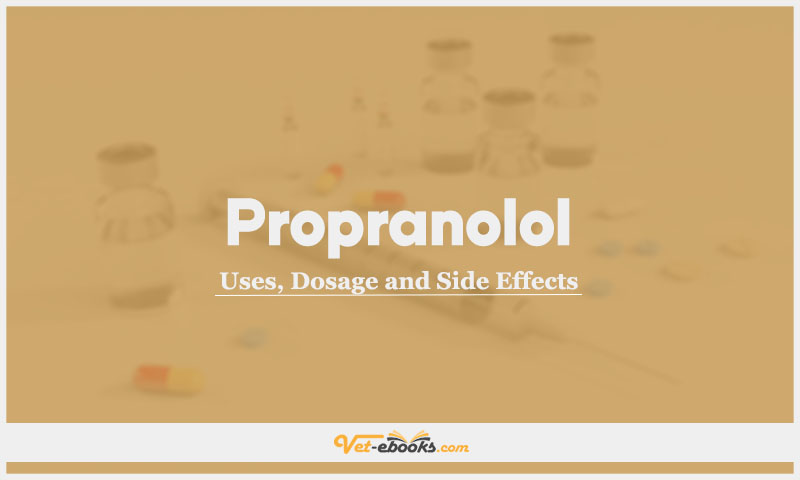Propranolol In Dogs & Cats: Uses, Dosage and Side Effects

Overview
Uses of Propranolol
- Management of cardiac arrhythmias, including sinus tachycardia, atrial fibrillation or flutter, supraventricular tachycardia, and ventricular arrhythmias.
- Treatment of hypertrophic cardiomyopathy or obstructive cardiac disease, particularly in cases of severe aortic or pulmonic stenosis.
- Potential use as an additional antihypertensive medication.
- Utilization following the introduction of alpha-blockade in the management of phaeochromocytoma, a rare adrenal gland tumor.
- Application in reversing certain clinical features of thyrotoxicosis before surgery in patients with hyperthyroidism.
- Use in behavioural therapy to reduce somatic signs of anxiety, making it beneficial for managing situational anxieties and behavioural issues involving contextual anxiety. Some experts recommend combining propranolol with phenobarbital for fear- and phobia-related behaviour problems.
Dose of Propranolol in Dogs and Cats
Dogs:
- Cardiac indications: 0.02–0.08 mg/kg i.v. slowly over 5 min q8h; 0.1–1.5 mg/kg p.o. q8h. Start at the lower doses if myocardial function is poor and titrate upwards cautiously.
- Phaeochromocytoma: 0.15–0.5 mg/kg p.o. q8h in conjunction with an alpha-blocker.
- Behavioural modification: 0.5–3.0 mg/kg p.o. as required up to q12h.
Cats:
- Cardiac indications and severe thyrotoxicosis (thyroid storm): 0.02–0.06 mg/kg i.v. slowly (i.e. dilute 0.25 mg in 1 ml of saline and administer 0.1–0.2 ml boluses i.v. to effect); 2.5–5 mg/cat p.o. q8h.
- Behavioural modification: 0.2–1.0 mg/kg p.o. as required up to q8h.
Drug Dosage Calculator
You Should Give:
Side Effects of Propranolol in Dogs and Cats
- Bradycardia (slow heart rate)
- AV block (atrioventricular block)
- Myocardial depression
- Heart failure
- Syncope (fainting)
- Hypotension (low blood pressure)
- Hypoglycemia (low blood sugar)
- Bronchospasm (difficulty breathing)
- Diarrhea
- Peripheral vasoconstriction (narrowing of blood vessels in extremities)
- Depression and lethargy (CNS penetration may cause these)
- Exacerbation of pre-existing renal impairment
- Risk of exacerbating arrhythmias or developing hypertension with sudden withdrawal
Contraindications of Propranolol in Dogs and Cats
- Do not use in patients with bradyarrhythmias, acute or decompensated congestive heart failure.
- Relatively contraindicated in animals with medically controlled congestive
heart failure as is poorly tolerated. - Do not administer concurrently with alpha-adrenergic agonists (e.g. adrenaline).
- Care in cats with lower airway disease.
Some Notes:
- There is a significant difference between i.v. and oral doses.
- This is a consequence of propranolol’s lower bioavailability when administered orally as a result of decreased absorption and a high first-pass effect.
- Wean off slowly when using chronic therapy.
- Propranolol’s hypotensive effect is potentiated by agents that depress myocardial activity, including anesthetic agents, phenothiazines, antihypertensive drugs, diuretics, and diazepam.
- Concurrent use of propranolol with calcium-channel blockers can increase the risk of bradycardia, severe hypotension, heart failure, and AV block.
- The administration of digoxin alongside propranolol can enhance the risk of bradycardia.
- Thyroid hormones accelerate the metabolism of propranolol, reducing its effectiveness.
- When initiating carbimazole therapy, the dose of propranolol may need to be reduced.
- Oral aluminum hydroxide preparations can reduce the absorption of propranolol.
- Cimetidine may decrease propranolol metabolism, leading to increased blood levels of the drug.
- Propranolol can intensify the effects of muscle relaxants such as suxamethonium and tubocurarine.
- Phenobarbital or phenytoin, which induce hepatic enzymes, may increase the rate of propranolol metabolism.
- When administered with propranolol, there is an increased risk of lidocaine toxicity due to reduced clearance of lidocaine.
- Propranolol can block the bronchodilatory effects of theophylline.
- While propranolol is not contraindicated in patients with diabetes mellitus, insulin requirements should be monitored because propranolol can enhance the hypoglycemic effect of insulin.
Tip
Do You Want To Increase Your Veterinary Knowledge and Practical Skills?
You Can Now Browse and Download +3000 Books For Veterinary Professionals & Students Online.
Download Veterinary Books




















